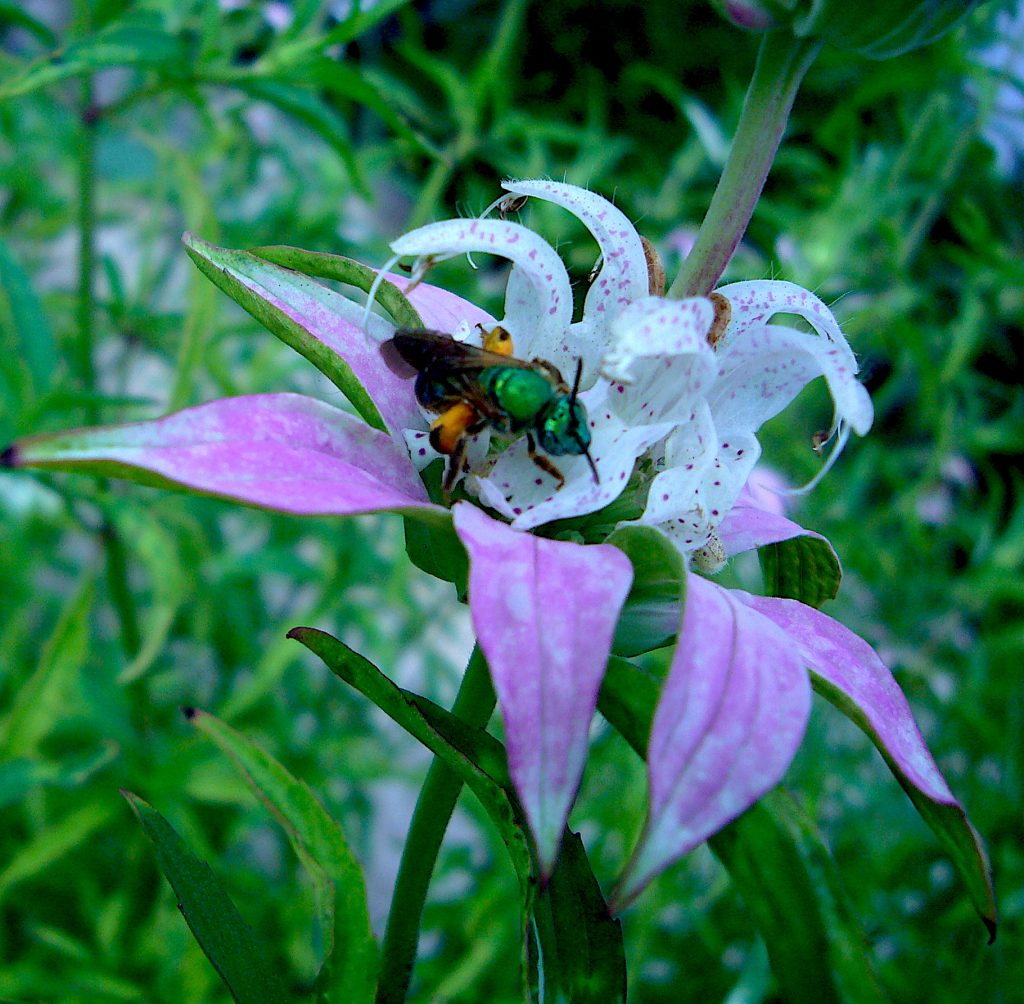
It’s the time of year when Horsemint is easy to find. Yes, it has been mentioned before but it’s worth mentioning again. To find it I could just say look for all the insects attracted to it. Horsemint is popular plants with the… Insecta Crowd. Or, you can just look for large pink bracts. Bracts are akin to lower leaves right below the blossom. (The bright red parts of a Poinsettia at Christmas are bracts. The Poinsettia blossoms themselves are small and nondescript.) On the Horsemint the bracts are easy-to-spot identifiers. The species also likes a specific environment which is high and dry or about as far from a swamp as you can get. Most of the time you will spot them while driving. Many roads in Florida cut through sand hills. This often creates upward sloping banks on either side of the road. That’s exactly where Horsemint likes to grow with or without vegetative competition. They are also colonial: Where you find one you usually will find many. Horsemint also has other interesting properties. To read more about it go here. I also have a video.
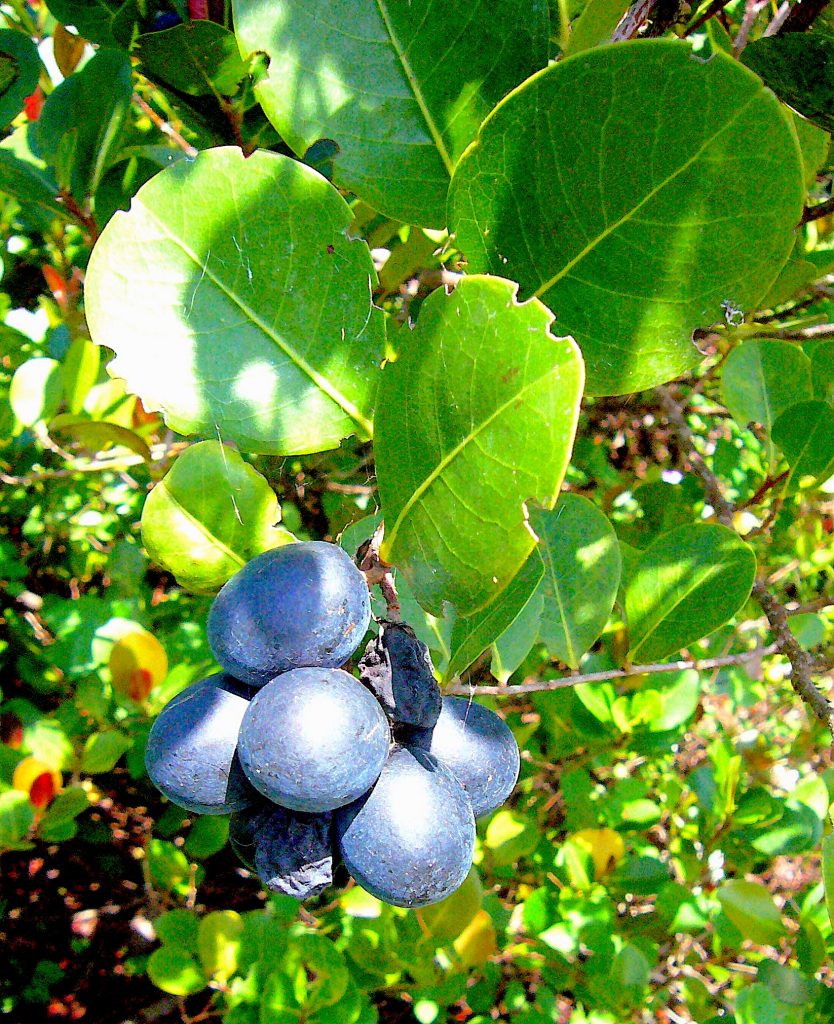
In Port Charlotte last Saturday we found some ripe Cocoplums. Like Natal Plums. they are not actually plums but about the right size to be called that. Cocoplums come in three colors: White, dark red, and a dark blue purple that is almost black. Cocoplums are not everyone’s favorite but I like them and the seed tastes like granola or almonds. Next on the fruit find were Ground Cherries. Like the “plums” above Ground Cherries are not cherries but more closely related to tomatillos. We found a few ripe ones. They can produce all year but tend to have two seasons, before and after the summer heat. Following the Ground Cherries were Simpson’s Stoppers. The sweet berries are often in pairs and resemble marmalade in flavor with a slight bitter aftertaste. They were not yet fruiting in Port Charlotte but two weeks ago were fruiting in Largo. A big find — literally — was a Jambul Tree, which like the Cocoplum comes in three colors, white, red and dark purple. It’s a large commercial product in the Asian part of the world. Even when totally ripe and sweet there is a bit of astringency. What is odd this year is the fruiting time. It’s usually heavy with fruit in August but I think late rains in May has thrown the season off. And the Jambul is not just a south Florida resident. They also thrive and fruit mid-state in Orlando. And in our foraging in Orlando class Sunday one of the more unusual finds was Ringless Honey Mushrooms. That’s a species we usually see in November or so. However, there have been reports of them flushing because of the rain and we found a bunch just starting. And if Tropical Storm/Hurricane Dorian hits this weekend we might be overrun with mushrooms next week. Speaking of mushrooms…
It’s interesting that the current recommendation for eating mushroom — even cultivated store-boughten ones — is that they be cooked. Who suggested that I do not know but it is the mainstream view new based on genetics. One argument is only a small percent of the population have the enzymes to completely digest the chitin raw mushroom contain, a few more can digest it poorly and most not at all. This, it is reported, leads to gastro-intestinal distress et cetera. If true this raises other issues: Most insects have chitin and if we can’t digest chitin then maybe insects are not a good source of food. However, we do seem to eat insects and I personally have been eating shrimp shells (yes I eat the entire shrimp shells and all) for more than 30 years. That chitin doesn’t seem to bother me and I find it flavorful. But back to mushrooms…
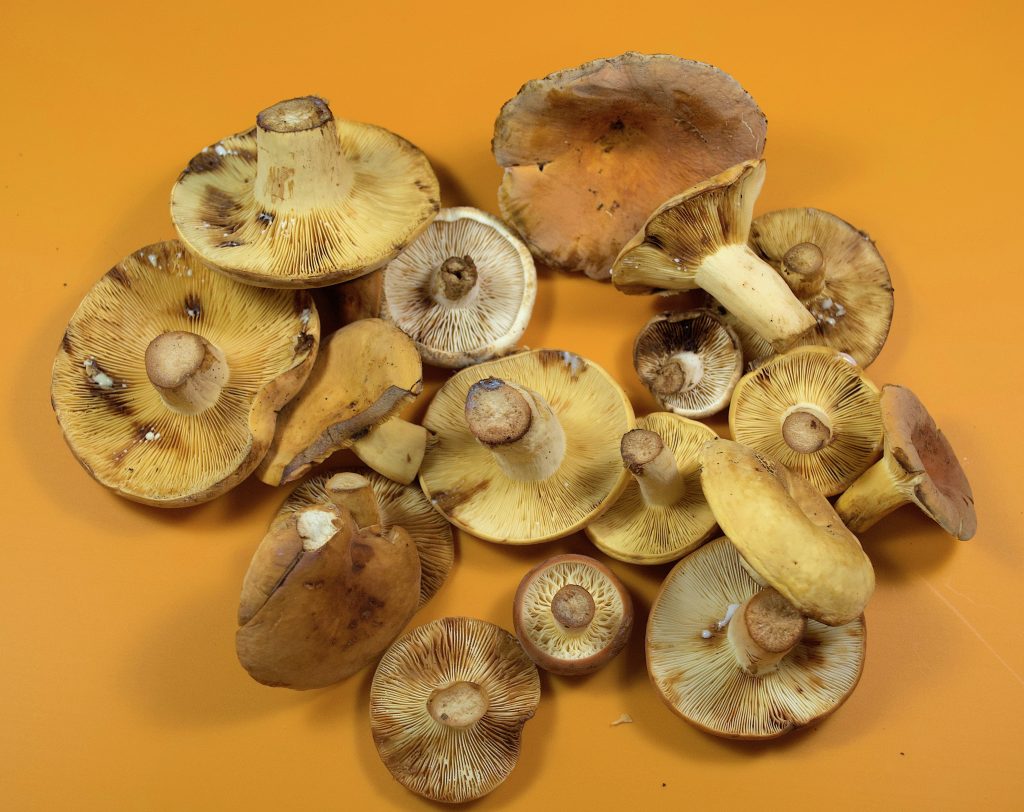
More salient perhaps is a 2015 study that found boiling edible mushrooms decreased their arsenic bioaccessibility as much as 71% depending upon the species. Frying them reduced the arsenic bioaccessibility by 11%. From a reduction-of-arsenic point of view boiling mushrooms is better than frying. But there are two devils in the details. The three species they tested are all cultivated: Shiitake, grocery store button mushrooms, and oysters. Would wild ones have yielded different results? And… there is toxic arsenic and nontoxic arsenic made by plants. It is not reported which arsenic the researchers were detecting. Also which ever arsenic it was it was far more present in “ground” grown mushrooms than log- or wood-grown mushrooms. This suggested, according to the researchers the nontoxic arsenic — at least — was involved in structural support of the non-log raised mushrooms. (I guess that means mushrooms that grow on wood are sturdier and mushrooms that grow on the ground need more internal support.) And to confuse the issue one report said: “Except for Agaricus sp. (with predominantly the nontoxic arsenic compound arsenobetaine ) inorganic arsenic predominated in most of the store-bought mushrooms (albeit with low total arsenic concentrations). Should inorganic arsenic predominate in these mushrooms from contaminated areas, the risk to consumers under these circumstances should be considered.”
Humans have been eating mushrooms long enough for each culture to know which ones kill quickly, which ones sicken, and which ones do not. Cooking mushrooms was not an option for a long time (nor was cooking insects.) One might construe that to mean humans were not made to eat mushrooms or insects but that would also have to apply to a lot of foods that are easier to digest and more nutritious if cooked.
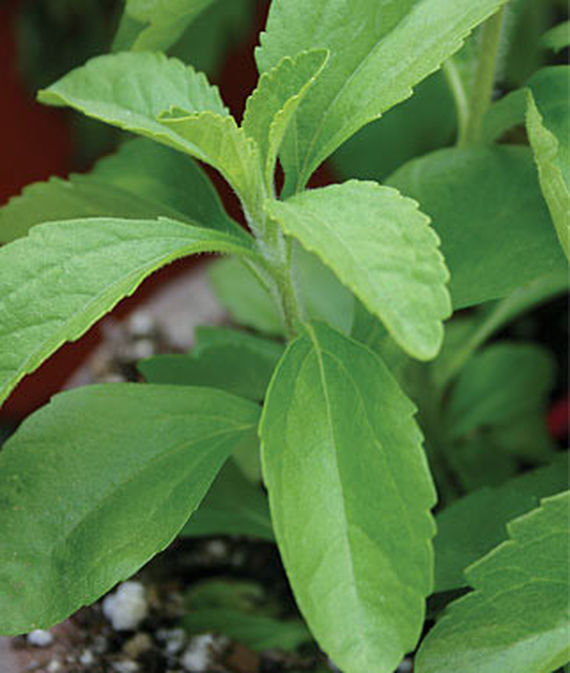
Is there a Stevia Ragweed connection? I recently heard a doctor say there was but it was, shall we say, an informal remark. She said her husband can’t use Stevia because he is allergic to Ragweed. She then said the species are related. That is technically but distantly true. Both species are in the Aster Family which has some 22,000 members. It’s the largest of all plant families. Indeed, when folks have a difficult time identifying a plant they often call it a DLA… a Dirty Little Aster. Other than being in the same 22,000-member clan there is little else in common with the two. Also Stevia is consumed. If it is an allergen it would have to be by consumption. Ragweed has irritating pollen and is breathed in, a totally different mechanism. (Meaning people who are allergic to Ragweed would be able to eat it if it were edible.) I think the good doctor made a leap rather than a fact-supported deduction. You can grow Stevia in Florida. Unprocessed Stevia leaves are actually quit bitter.

Weather may interfere with classes this weekend. The class Saturday in Apopka is probably unaffected by the approaching tropical weather. Or if it is it would probably be just rain and we hold classes in the rain. However, current prediction have the storm coming ashore on the east coast of Florida Sunday morning. It was coming ashore right at Ft. Pierce exactly when class is to start Sunday there at George LeStrange Preserve. Now they have move the landing further north. If the veers east a little and lands further north south Florid might be sunny Sunday morning. I will leave Ft. Pierce on the schedule in case “Dorian” moves out to sea or dissipates. We should have a good idea Friday. If it brings storm condition to the Ft. Pierce area that class will not meet.
Saturday August 31st, Wekiva State Park, 1800 Wekiwa Circle, Apopka, Florida 32712. 9 a.m. to noon. Arrive very early as there will be a lot of people wanting to go to the springs at 8 a.m. to swim. There is a park admission Fee: $6 per vehicle. Limit 8 people per vehicle, $4 for a single occupant vehicle, $2 pedestrians or bicyclists. Meet at the Sand Lake parking lot (road on left after entrance. Go to end of road.) Unlike city parks or the urban area, Wekiva Park is “wild” Florida. There are very few weeds of urbanization. The edibles are mostly native plants and far between. There is a lot of walking in this class. After class you can swim in the spring.
Sunday September 1st, George LeStrange Preserve, 4911 Ralls Road, Fort Pierce, FL, 34981. 9 a.m. to noon. The preserve has no official bathroom or drinking water so take advantage of the various eateries and gas stations before arrival.
Saturday September 7th, 329 N. Park Avenue, Winter Park. 9 a.m. to noon. Parking is free in the parking garage behind Panera’s. This is a class specializing in finding wild edibles in an urban setting.
Sunday September 8th, Ft. Desoto Park, 3500 Pinellas Bayway S. St. Petersburg Fl 33715. Meet by the bathrooms at the parking lot of the “bay” fishing pier (not the “gulf” fishing pier.) 9 a.m. to noon. There is a fee to get into the park. The fishing pier is about halfway along the SW/NE road along the southern end of the park.
Saturday, September 14th, Wickham Park: 2500 Parkway Drive, Melbourne, FL 32935-2335. 9 a.m. to noon.Meet at the “dog park” inside the park.
October 11-12-13, foraging classes at Putney Farm, Honea Path, South Carolina.

We shouldn’t forage along railroad tracks and you can blame it all on the Russian Thistle. This species, best known as the tumble weed that rolls across the wild west in movies, came with immigrants to southern South Dakota in the early 1870’s. Best guess is it contaminated their flax seed. By 1895 it reached New Jersey and California. The question was how? A professor who worked for the Department of Agriculture figured out the trains were spreading the seeds coast to coast. It was a remarkable idea at the time and brought him much fame. His solution to the unintentional distribution? Kill plants long railroad tracks. Thus began the practice of putting down some mighty and long-lasting chemicals to kill weeds sprouting amongst the iron rails. Railroad tracks are a good place to find seeds to take home and plant but not to find food. There have even been a few reported deaths from foraging along rail road tracks.
Also seen blooming now is Goldenrod. It’s a bit of a treasure hunt and disappointment. The treasure hunt is that one species is better than all the rest for tea, Solidago odora. It does grow here, has an anise flavor, but is hard to find. It’s reported in most counties but is not common. Goldenrod grows in about half of the United States, southwest to northeast. Other Goldenrod species can also be made into tea, perhaps all of them particularly for herbal applications, but they don’t taste anywhere near as good. In fact, after the “Boston Tea Party” of 1773 halted tea imports colonialists drank Goldenrod tea and even exported some to China. It did not catch on. However, every time I see a Goldenrod I pull off a leaf and crush it hoping to detect the tell-tale anise smell. It’s a golden treasure hunt.
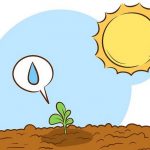
Donations to upgrade EatTheWeeds.com have gone well. Thank you to all who have contributed to either via the Go Fund Me link, the PayPal donation link or by writing to Green Deane POB 941793 Maitland FL, 32794. And I am in the process of writing to folks who are interested in exchanging some webmastering for foraging classes. As they used to say when we had television with antennas, stay tuned.
This is weekly newsletter 370. If you want to subscribe to this free newsletter you can find the sign-up form in the menu at the top of the page.

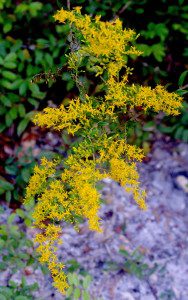

I wholeheartedly agree with you on the Solidago odora. I discovered it last year on the edges of a wood line that we frequently forage. I found it this year along a path in a mostly shady woods. It’s shorter and much smaller than the other Solidago in our zone 7, Upstate SC area and easy to overlook. I transplanted a small patch into my herb garden and it is doing great! It is my absolute favorite to make hot tea with. I infused a jar of honey with the leaves and blooms and it is amazing as well.
I’m still in Doha , Quatar. Interestingly, in this time of the year I’ve found for the first time the same weed I had been accustmed to see in my home Sudan . There , Phthyllus niruri grows richly during the rainy season as evident nowadays. However, the plant itself is phenomenal in that it carries its blossoms, hence its seeds, under its multileaflet leaves in the early days of growth. Suffice to say the plant is famous for use – as tea – in auyrvedic medicine.